Wednesday, 26 April 2017
| Room 320 |
16:15 - 18:15 |
Moderators: Vincent Boer, Johanna Vannesjo |
Slack Channel: #s_int_eng_safety
Session Number: O83
16:15
|
0962.
 |
Real-time B0 concomitant field compensation for a compact 3T MR scanner with asymmetric transverse gradients 
Paul Weavers, Shengzhen Tao, Joshua Trzasko, Yunhong Shu, John Huston III, Louis Frigo, Erin Gray, Thomas Foo, Matt Bernstein
A prototype, high-performance gradient system capable of 80 mT/m and 700 T/m/s with asymmetric design has been installed. Zeroth-order concomitant field terms endemic to MRI systems employing asymmetric gradient designs cause blurring and ghosting in spiral scans, as well as image quality degradation in fast-spin-echo imaging. The theory is reviewed, and a real-time hardware compensation is demonstrated to correct for the effect.
|
16:27
|
0963.
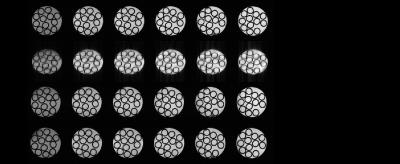 |
Combined imaging and shimming with the Dynamic Multi-Coil Technique 
Umesh Rudrapatna, Fabian Fluerenbrock, Terence Nixon, Robin de Graaf, Christoph Juchem
Spatial encoding and shimming in MRI commonly use dedicated coils that generate spherical harmonic fields. Recently introduced dynamic multi-coil technique (DYNAMITE) demonstrates that MRI-relevant magnetic fields can also be created by a generic set of coils that produce non-linear and non-orthogonal fields, through successful implementation of dynamic shimming, linear and non-linear encoding. Here, purely DYNAMITE-based, concurrent spatial encoding and B$$$_{0}$$$ shimming is demonstrated. The successful synthesis of all encoding and shimming fields with DYNAMITE encourages the simplification of MR scanner architecture by substitution of multi-layer spherical harmonic coil systems with a single-layer multi-coil array.
|
16:39
 |
0964.
 |
Real-time shimming of the human spinal cord using a 24-channel shim array coil 
Ryan Topfer, Alexandru Foias, Nikola Stikov, Julien Cohen-Adad
Pathologies of the spinal cord are a primary cause of functional disability and chronic pain. Although MRI already plays a role in the evaluation of these pathologies, it continues to be hampered by artifacts due to magnetic field inhomogeneity. This study reports the first results from applying a specially designed 24-channel shim array to compensate respiration-induced magnetic field inhomogeneity in the human spinal cord in real-time. This approach has the potential to improve the quality of EPI and spectroscopy in the spinal cord.
|
16:51
|
0965.
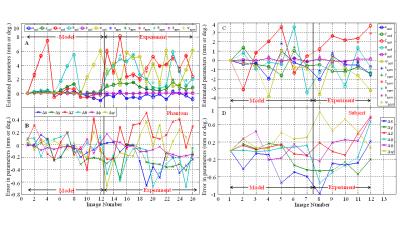 |
Tracking head movement inside an MR scanner using voltages induced in coils by time-varying gradients 
E. Bhuiyan, G. Spencer, P. Glover, R. Bowtell
We evaluate a new approach for monitoring head movement inside an MR scanner, which exploits the linear variation of the voltages induced in a set of coils by time-varying magnetic field gradients with respect to small changes in position/orientation. This approach was tested by attaching five coils to a structured agar phantom and a healthy volunteer’s head. The results suggest that it is possible to estimate the position and orientation with 0.22mm and 0.24° root-mean-square error using this set-up. The new approach could be used for prospective or retrospective motion correction.
|
17:03
|
0966.
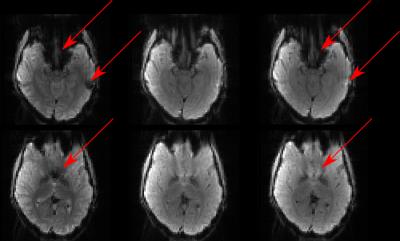 |
Combined multi-band z-shimming using a novel auto-calibration routine 
Michael Schwerter, Seong Dae Yun, N. Jon Shah
EPI images suffer from signal dropouts and z-shimming is an effective technique to recover parts of the lost signal. Its inherent drawbacks are a scan time prolongation and the necessity to estimate subject-specific z-shim gradient moments. We introduce multi-band imaging to z-shimming to eliminate the scan time prolongation and propose a novel method to estimate optimal z-shim gradient moments. The results show less signal dropout in the z-shimmed images and prove our z-shim gradient moment estimation to be robust and efficient. Due to a reduced anatomical contrast, our multi-band z-shim approach might be most beneficial for BOLD-contrast based fMRI.
|
17:15
|
0967.
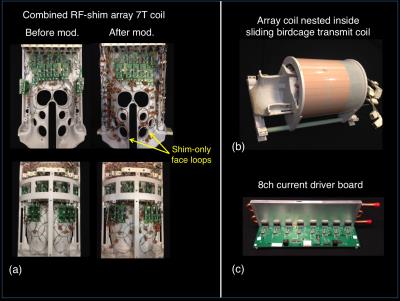 |
An integrated 32ch RF-shim array coil for improved B0 shimming of the brain at 7 Tesla 
Jason Stockmann, Thomas Witzel, Nicolas Arango, Azma Mareyam, Charlotte Sappo, Jiazheng Zhou, Joshua Park, Boris Keil, Lucas Jenkins, Markus May, Jonathan Polimeni, Jacob White, Lawrence Wald
Dual-purpose arrays of close-fitting coils, used to both receive RF and shim B0 to high spatial order, have recently been demonstrated in brain imaging at 3T. We extend this approach to 7T with an array comprised of: six RF coils, twenty-six RF/B0-shim coils, and six shim-only coils. The shim coils are driven by an array of low-cost current-feedback amplifiers that can steer up to fifty amps of shimming currents rapidly and accurately enough to allow for slice-by-slice adjustments. The resulting slice-optimal high-order shim capability (wires and chokes) improves σB0 in brain slices by up to 60% (as compared to static 2nd-order global shimming), while worsening SNR by less than 10%, and increasing coil coupling by less than 3%.
|
17:27
 |
0968.
 |
Monolithic Transmit Line Resonator as a Combined B1/B0-shim Coil Element 
Riccardo Stara, Mihir Pendse, Jason Stockmann, Brian Rutt
In this work we propose and evaluate, for the first time, the use of a single-turn-single-gap Transmit Line Resonator as a combined RF-transceive and B0-shim element. We compare this design to a standard loop in terms of both RF and B0-shimming performance. The benefits of our combined TLR/B0-shim design are improved RF performance due to the fixed and smaller number of lumped elements, and the increase in B0-shim efficiency. Our results show the TLR element design to be an ideal building block for high-channel-count integrated Parallel Reception, Excitation and Shimming (iPRES) arrays.
|
17:39
|
0969.
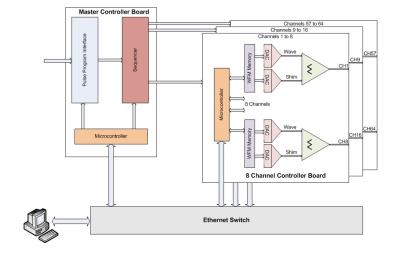 |
The Design and Implementation of a 64 Channel Arbitrary Gradient Waveform Controller 
Terence Nixon, Scott McIntyre, Robin de Graaf
Generating additional magnetic fields independently from the MR scanner’s hardware requires additional controllers, current amplifiers and DC coils. Here we present the design and implementation of a 64 channel arbitrary gradient waveform controller that can be used to drive current amplifiers with analog inputs. We describe the controller’s architecture and how sequences are developed. We will also discuss the important criteria needed to synchronize the waveforms with the MR scanner. Finally, we will show the completed controller and the first MR result.
|
17:51
|
0970.
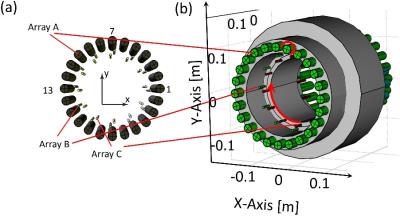 |
Dynamic permanent magnet array for ultra-low field magnetic resonance imaging 
Michael Vogel, Viktor Vegh, Ruben Pellicer Guridi, David Reutens
Conventional MRI scanners rely on superconducting magnets making them heavy and expensive and putting MRI beyond the reach of much of the world’s population. Ultra-low field (ULF) MRI instruments offer the possibility of novel image contrast mechanisms, are less costly and are potentially portable, enabling use in unconventional situations. This project addresses ULF-MRI’s biggest challenge, low signal-to-noise ratio, by using the novel approach of dynamic, mechanically-operated small permanent magnet arrays to generate the magnetic fields required for prepolarisation and spatial encoding.
|
18:03
 |
0971.
 |
Multi-slice metabolite mapping with Very-High Degree Dynamic B0 Shim Updating at 9.4T using Accelerated 1H FID MRSI 
Sahar Nassirpour, Paul Chang, Anke Henning
In this work, we address the problem of B0 inhomogeneity in the human brain at 9.4T by using dynamic very high order B0 shimming. This enables multi-slice metabolite mapping in the human brain at this field strength. Furthermore, we investigate the advantage of low (2nd) versus very high (4th+) degree dynamic B0 shimming directly with respect to the quality of the metabolite maps.
|
|











